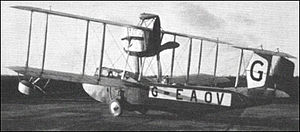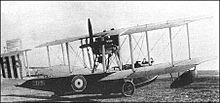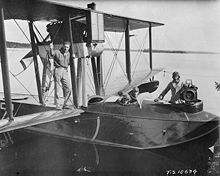Vickers Viking Video - Picture

|
|
Vickers Viking
Viking/Vulture/Vanellus

Picture - The Vickers Viking prototype in 1919
Role: Biplane amphibian
Manufacturer: Vickers / Canadian Vickers
First flight: 1919
Produced: 1919-1923
Number built: 31 (Viking)
2 (Vulture)
1 (Vanellus)
The Vickers Viking was a British single-engine amphibious aircraft designed for military use shortly after the World War I. Later versions of the aircraft were known as the Vickers Vulture and Vickers Vanellus.
Design and development
Research on Vickers' first amphibious aircraft type began in December 1918 with tests of alternative fuselage/hull designs occurring in an experimental tank at St Albans in Hertfordshire, England. A prototype, registered G-EAOV, was a five-seat cabin biplane with a pusher propeller driven by a Rolls-Royce Falcon water-cooled V 12 engine. Sir John Alcock died taking this aircraft to the Paris exhibition on 18 December 1919, whilst trying to land at Cx´te d'Evrard, near Rouen, Normandy in foggy weather.

Picture - A Royal Air Force Vickers Viking V
The next example, G-EASC, known as the Viking II, had a greater wing span and a 360 hp Rolls-Royce Eagle VIII motor. The Viking III machine, piloted by Captain Cockerell, won first prize in the amphibian class in Air Ministry competitions held in September and October, 1920.
The Type 54 Viking IV incorporated further refinements and had a wider cabin above a hull one foot wider, an example being G-EBBZ in which Ross Smith and J.M. Bennett (partners in the 1919 England to Australia flight) died on 13 April 1922 just outside the Brooklands racetrack near Weybridge in Surrey. Most of these Mark IV Vikings had a Napier Lion engine.
The next version was the Viking V, two were built for the RAF for service in Iraq.
The last Viking amphibians were built during 1923, but the name was re-used for the twin-engine VC.1 Viking airliner some 22 years later, which saw service as the Valetta with the RAF and other air arms. Some Viking amphibians were built by Canadian Vickers Limited, a subsidiary company in Montreal with no previous plane making experience.

Picture - A Vickers Viking IV of the Royal Canadian Air Force in 1926.
A further development with a redesigned wing structure using the 450 hp (340 kW) Napier Lion would have been the Viking VI (Vickers designation Type 78) but known as the Vulture I. A second with a Rolls-Royce Eagle IX (360 hp, 270 kW) was the Type 95 Vulture II. Both Vultures were used for an unsuccessful around the world attempt in 1924 after the Eagle engine of the Vulture II was replaced with a Lion. With registration G-EBHO, the first set off from Calshot Seaplane Base on 25 March 1924, the other was shipped as a spare machine to Tokyo. After mechanical difficulties in earlier staged G-EBHO crashed at Akyab where it was replaced by G-EBGO on 25 June. Encountering heavy fog on the Siberian side of the Bering Sea G-ENGO crashed. Vickers salvaged a large proportion.
The Viking Mark VII ("Type 83" in Vickers numbering) was a development of the Vulture, a three-seat open-cockpit fleet spotter to Air Ministry specification 46/22 given the service name Vanellus when taken on for evaluation by the RAF against the Supermarine Seagull design.

Picture - Vickers Vulture
Operators
Argentina
Argentine Naval Aviation - four Type 84 (Viking IV) delivered in 1923.
River Plate Aviation Company - two Type 73 (Viking IV) delivered in 1923.
Canada
Laurentide Air Services - One Type 69 (Viking IV) delivered in 1922.
Royal Canadian Air Force - two Type 85 (Viking IV) delivered in 1923 followed by six built in Canada by Canadian Vickers at Montreal.
France
French Navy - One Type 54 (Viking IV) delivered in 1921 with civilian markings.
Japan

Picture - Vickers Vanellus
Imperial Japanese Navy - two Type 58 (Viking IV) delivered in 1921.
Netherlands
Royal Netherlands East Indies Army Air Force - Eight Type 55 (Viking IV) delivered in 1922 followed two attrition replacements in 1923.
Russian SFSR
One Type 64 (Viking IV) orderd by the Russian Trade Delegation delivered in 1922.
United Kingdom
Royal Air Force - two Type 59 (Viking V) delivered in 1922 for tropical trials with No. 70 Squadron RAF.
United States
One Type 58 (Viking IV) delivered to the United States government in 1923.
Specifications (Viking IV)
Data from British Flying Boats
General characteristics
Crew: One: pilot
Capacity: 3 passengers
Length: 34 ft 2 in (10.42 m)
Wingspan: 50 ft 0 in (15.24 m)
Height: 14 ft 0 in (4.27 m)
Wing area: 635 ft² (59.0 m²)
Empty weight: 4,040 lb (1,836 kg)
Loaded weight: 5,790 lb (2,632 kg)
Powerplant: 1x— Napier Lion 12-cylinder water-cooled broad arrow piston engine, 450 hp (336 kW)
Performance
Maximum speed: 113 mph (98 knots, 182 km/h)
Cruise speed: 91 mph (79 knots, 147 km/h)
Range: 925 mi (804 nmi, 1,489 km) (long range tanks)
Endurance: 4 hr 45 min
Wing loading: 9.12 lb/ft² (44.6 kg/m²)
Power/mass: 0.078 hp/lb (0.13 kW/kg)
Climb to 3,000 ft (915 m): 3.2 min
Andrews, C.F. and E.B. Morgan. Vickers Aircraft since 1908. London:Putnam, 1988. ISBN 0 85177 815 1.
London, Peter. British Flying Boats. Stroud, UK:Sutton Publishing, 2003. ISBN 0-7509-2695-3.
External Links
"The Vickers VIKING Mark IV" FLIGHT, October 6th 1921, pages 655-660 detailed photos and drawings
Vickers Viking entry at the Lancaster Museum website
Canadian Air Force historical aircraft
Viking Vulture entry at Avia Russia website
Vickers Viking Pictures
Living Warbirds: The best warbirds DVD series.
Source: WikiPedia